Football/Soccer Session (Academy Sessions): Keeping Shape/positional responsibilities (Start Time: 2018-04-24 11:55:00)

Profile Summary

| Name: | Gene Kopecky |
|---|---|
| City: | Rochester |
| Country: | United States of America |
| Membership: | Adult Member |
| Sport: | Football/Soccer |
Description
Credit goes to Brett McBride and Scott Jenkins for the basis of the this lesson plan.
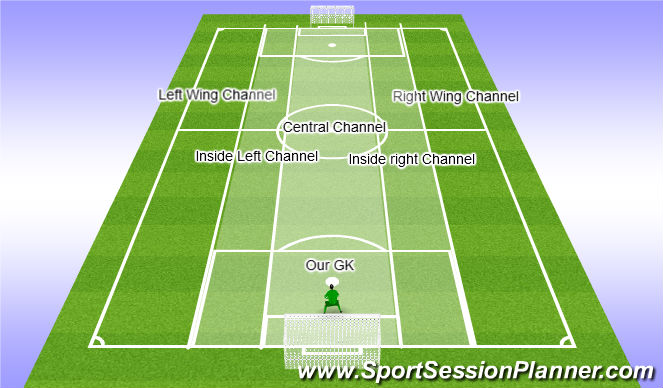
See the guidance at the top of this page to understand why you are not seeing interactive Football/Soccer images.

Vertical Channels (5 mins)
Vertical Channels
The field can be divided into 5 vertical channels running from goal line to goal line. With our goal behind us and facing the opponents goal, from right to left, the vertical channels are: Right Wing Channel, Inside Right Channel, Central Channel, Inside Left Channel, and Left Wing Channel. These run the length of the field.
These channels are not set in stone as you are encouraged to overlap and change fields, however, the key for success is going to be how you communicate with your teamates. Be specific, so no one has a question in what you are doing.
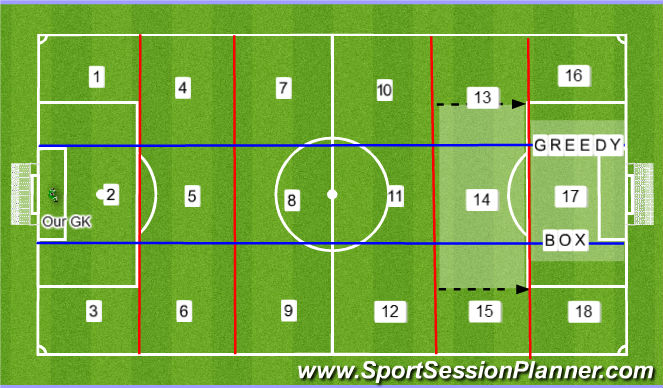
See the guidance at the top of this page to understand why you are not seeing interactive Football/Soccer images.

Zones (10 mins)
Zones
The field can also be divided into 18 zones by dividing the width into three and the length into 6.
We have divided the pitch into nearly equal size pieces and numbered them.
These are referred to as Zones and they are simply a way to break down the field.
Of importance are Zone 14/17 and the halfspaces of Zones 13/16 and 15/18 (shaded area). It is from here that statistically most goals are scored (17/16/18) / created (14/13/15)! 17/16/18 is also called the Greedy Box. Chaos can ensue and if not careful own goals can be scored just as easily as goals for your team.
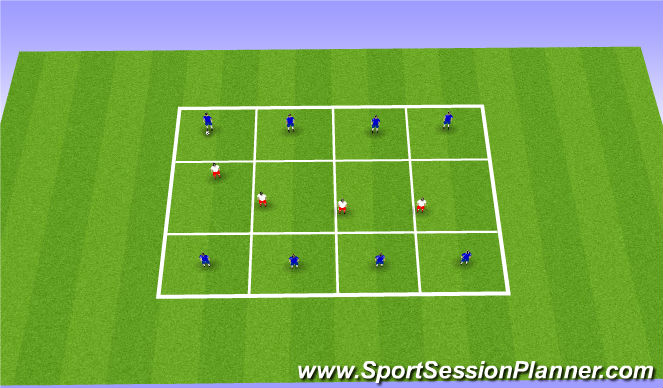
See the guidance at the top of this page to understand why you are not seeing interactive Football/Soccer images.

Flat defensive formation (15 mins)
Each player is in their own gride and cannot cross over.
Defense is in the middle four.
Defenders are working on their pressure, cover, balance
Offense trying to get ball through defense with pass.
Each pass across results in a point for offense.
Keys: positioning, talking, keeping eye on ball
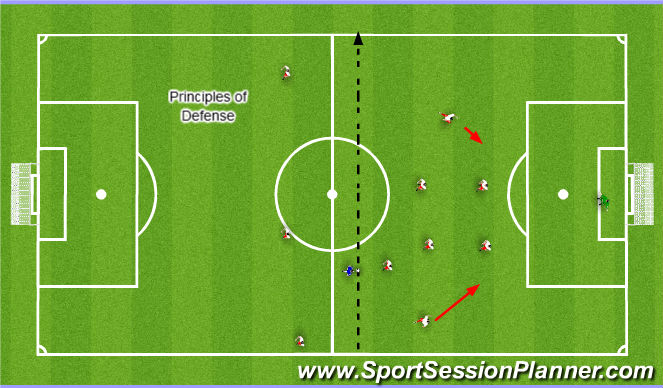
See the guidance at the top of this page to understand why you are not seeing interactive Football/Soccer images.

Principles of Def (20 mins)
Moments of the Game
So far the break down of the game has been limited to the physical aspects of the field. Now we can break down all of the action during a game into 3 Moments.
1. The Moment when we have possession of the ball - In Possession
2. The Moment when the other team has possession of the ball - Out of Possession
3. The moment of transition when neither team has the ball or more often just after one team loses the ball and the other team gains possession but neither team is in their appropriate Def or Attacking shapes - Transition
Principles of Defense
When out of posesssion we want to execute a defensive plan and recover into defensive shape behind the ball. To help us defend effectively we should observe the defensive principles These principles make up the defensive half of the Principles of Play. These principles apply no matter what system of play the team is using.
Principles of Defense
1. Pressure
2. Cover
3. Balance aka the teter totter approach
4. Compactness when being attcked
5. Communication!!!!!!!!!!
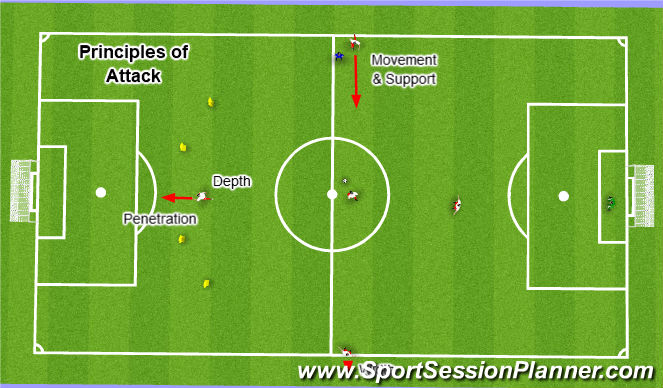
See the guidance at the top of this page to understand why you are not seeing interactive Football/Soccer images.

Principles of Attack (20 mins)
Principles and Phases of Attack
In Possession
Principles of Attack
1. Depth
2. Width
3. Penetration
4. Movement and Support
5. Creativity and Imagination
Phases of Attack
1. Build Up/Out from the back
2. Consolidation up front when finishing
3. Incisional passing aka moving to space to get the ball
4. Finish
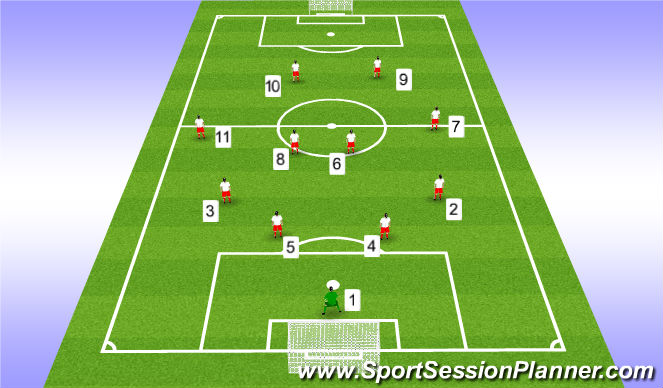
See the guidance at the top of this page to understand why you are not seeing interactive Football/Soccer images.

Numbering System (20 mins)
Tactical Numbering System
The Tactical Numbering System is a way to describe positional roles within a certain system of play by assigning numbers to positions previously known by many regional names. Many coaches and commentators use these and I will too where I think they are useful. I understand the positional roles best when used to describe a system of play formed up as a 1-4-4-2.
1 = GK
2 = Right Back
3 = Left Back
4 = Def Center Back
5 = Att Center Back
6 = Defensive Center Mid
7 = Right Winger
8 = Att Center Mid
9 = Center/primary Forward/Striker
10= Second Forward/Striker
11 = Left Winger









 Play animation
Play animation Play step-by-step
Play step-by-step Repeat (toggle)
Repeat (toggle) Full Screen
Full Screen Pause
Pause Stop
Stop
Physical and Imaginary Lines on the Field (5 mins)
Lines on the Field
A = Touch line aka sideline
B = Goal line
C = Penalty Area aka The 18 (Shaded area where C is located)
D = Goal Box aka The 6 (Shaded area where D is located)
E = Halfway line
F = Restraining Arcs
Thirds
The green lines are imaginary lines that divide the field across from Touch line to Touch line, into thirds. The third that has the goal in it that we are defending is called the Defensive Third. The third on the other side with the goal that we are trying to score in is called the Attacking or Offensive Third. The third in between the Def and Attacking Thirds is called the Middle Third.